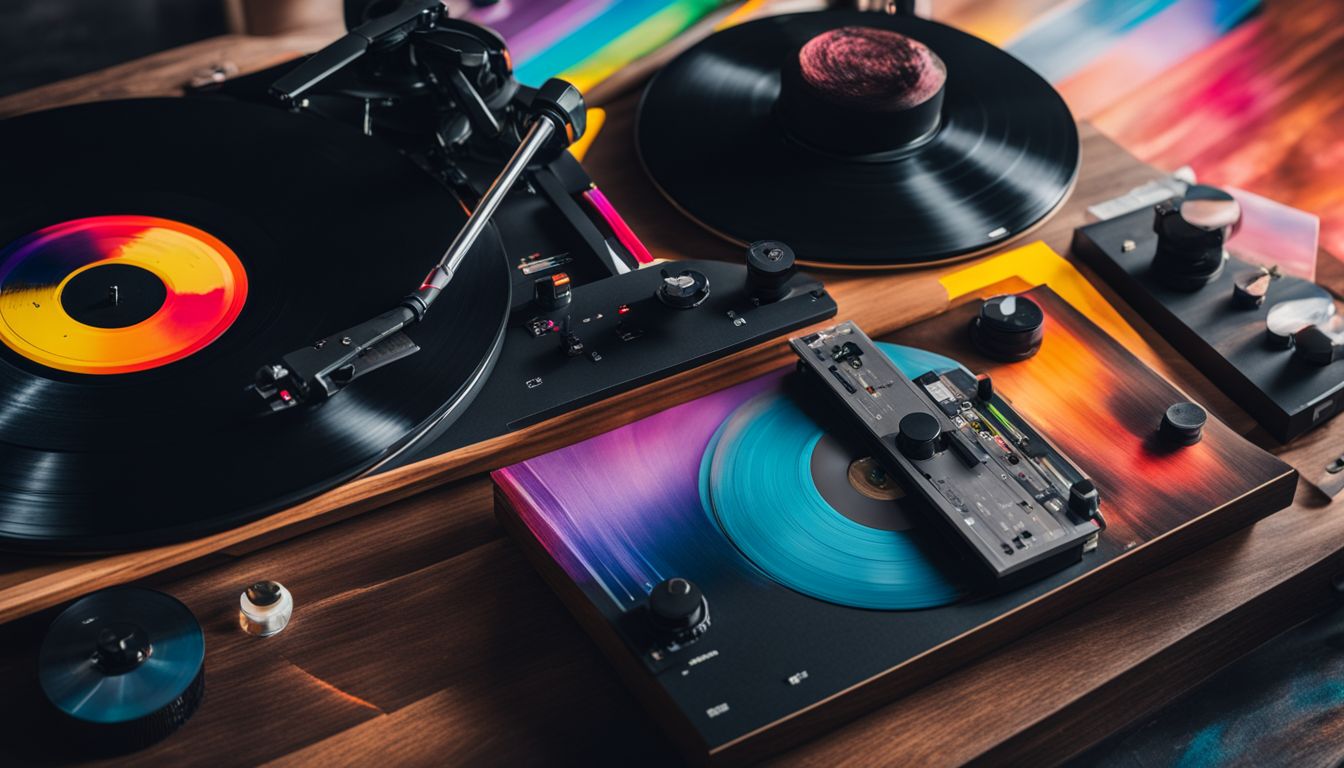If you’ve ever watched a DJ and wondered how they weave fresh rhythms out of familiar tracks, you’re not alone. Beat juggling is the mesmerizing art form behind these on-the-fly mashups, pioneered by hip-hop DJs who turned turntables into musical instruments.
This blog post will break down the energetic world of beat juggling, showing you its history, techniques, and influence on music production today. Dive in to discover the pulse behind those head-nodding beats!
Key Takeaways
- Beat juggling is a skill where DJs mix and create new rhythms by manipulating two or more audio samples, often using vinyl records on turntables.
- DJ Steve Dee pioneered beat juggling in the mid-1980s, which then became an essential part of hip-hop culture and influenced music production across genres.
- Techniques involved in beat juggling include scratching, backspins, pauses, delays, looping, strobing, body moves, and the carousel effect to build unique sound patterns.
- Mastery of beat juggling requires understanding rhythm structure and timing; it enhances live performances by allowing DJs to serve as both remixers and composers on stage.
- The art form has evolved with technology—digital advancements have expanded the possibilities for creative expression within music production.
Beat Juggling: A Comprehensive Guide
Beat juggling is a transformative aspect of turntablism, where DJs artfully manipulate vinyl to create new rhythms and sounds. It stands as an intricate skill that blends timing, creativity, and technical prowess to redefine the boundaries of traditional DJing.
Definition
Beat juggling is the craft of taking two or more audio samples and manually mixing them to extend a beat or create a completely new rhythm. DJs use their deft skills on turntables, manipulating vinyl records or other media to layer sounds in real-time.
This technique isn’t just about playing tracks side by side; it’s about creating a live remix that can incorporate various elements such as drum beats, vocal snippets, or instrumental loops.
This form of musical alchemy requires precise timing and control, often involving complex maneuvers with the DJ mixer and the turntable platters themselves. From scratching to backspins and strategic pauses, each action adds to the intricate dance of sounds that defines beat juggling.
It transcends simple playback; it’s an art where turntablists like Grandmaster Flash, Rob Swift, and DJ Steve Dee construct something entirely fresh from existing pieces of music, much like a chef crafting a new dish using classic ingredients.
History
DJ Steve Dee ignited the technique of beat juggling in the mid-1980s, making history by manipulating cuts and remixing beats live. He pioneered a new way for DJs to control the rhythm and flow of music by using two copies of the same record.
This skill quickly spread, becoming a cornerstone in hip-hop culture and DJ performances around the world.
As digital technology evolved, beat-juggling burst through its vinyl boundaries. The arrival of compact disc DJ players and controllers opened up endless possibilities for DJs to weave together intricate soundscapes without being limited to analog equipment like direct-drive turntables or conventional mixers.
The influence on music production was profound, as this art form seamlessly integrated with modern mixing consoles, CDJs, and sound systems that dominate today’s vibrant scene.
Techniques
As we trace the evolution of beat juggling from its early days, we dive into the myriad techniques that make this art form a cornerstone of modern DJing. Skilled turntablists and DJs manipulate sounds to create rhythmic patterns that are as complex as they are captivating. Here’s how they do it:
- Pauses: This technique involves temporarily stopping the record with the hand and then releasing it in time to create an interrupted rhythm or to emphasize a particular beat.
- Scratching: One of the hallmark skills, scratches add texture and flair to music. DJs move the record back and forth under the needle, producing sharp sounds that punctuate the mix.
- Backspins: By spinning the record backwards quickly, DJs can replay certain beats or sound bites, effectively “rewinding” live for dramatic effect.
- Strategically pausing between sounds or beats creates delays, adding a sense of anticipation before the next burst of audio punches through.
- Looping: A loop repeats a section of music over and over again, allowing DJs to extend breaks and build tension within their set.
- Strobing: Strobing happens when a DJ toggles between two similar tracks rapidly, creating an oscillating audio pattern akin to a strobe light’s visual effect.
- Body moves: Incorporating physical movements can be part of beat juggling too; hitting the EQs, tweaking knobs, or even using elbows can influence the sound flow.
- Carousel: With multiple records at play, switching from one turntable to another in rapid succession gives rise to a carousel effect—a continuous cycle of beats that keeps evolving.
The Connection of Beat Juggling to Hip-Hop
Beat juggling forms a critical pillar in the hip-hop world, shaping the music’s rhythm and flow. DJs who master this skill become architects of sound as they blend beats and break records to energize crowds.
Hip hop’s pulse owes much to these sonic craftsmen who manipulate records with precision. They bring fresh sounds out of old tracks by repeating breaks, creating loops on the fly.
Icons like DJ Kool Herc ignited this movement by extending instrumental breaks for dancers at block parties—a practice that evolved into beat juggling. The technique became central to hip-hop culture, influencing not just dance moves but also MCs’ rhymes.
Groups like The X-Ecutioners pushed boundaries further, using beat juggling in performances that showcased turntablism as an art form integral to hip hop’s expressive complexity.
The Art of Scratching and Beat Juggling
Delve into the syncopated world where DJs combine rhythmic prowess with technical skill, turning turntables into instruments that captivate audiences; continue reading to unlock the secrets behind these dynamic performances.
Basics of Scratching (including DJ Scratching)
Scratching is a vital DJ technique that brings life to the mixtape. It requires precision and creativity to masterfully manipulate sound using turntables or digital controllers.
- Start with getting to know your equipment intimately; it’s fundamental for achieving precise control over the sounds you create.
- Learn how to properly hold a record with fingers positioned so that you can apply pressure without causing the vinyl to skip or damage.
- Practice basic scratching movements, such as the baby scratch, which involves moving the record back and forth gently without crossfader involvement.
- Incorporate the use of a crossfader, which allows you to smoothly transition between sounds and create rhythmic patterns.
- Develop timing skills by scratching in sync with the beat. This helps maintain flow within a set and adds professionalism to your performance.
- Experiment with advanced techniques like cutting, flaring, and chirping to diversify your sound palette and keep audiences engaged.
- Pay attention to different styles of scratches used in rare groove tracks; this exposes you to diverse approaches and can inspire unique combinations.
- Engage with music theory basics—understanding beats, bars, and tempos enhances your ability to scratch musically rather than just technically.
- Constantly record yourself scratching; listening back helps identify areas for improvement and track progress over time.
- Seek out tutorials from experienced DJs who often share insights on technique refinement and creative applications of scratching.
Fundamentals of Beat Juggling
Mastering the fundamentals of beat juggling is essential for any aspiring DJ. It’s more than just playing tracks—it’s about creatively manipulating beats to make something entirely new. Here are the key techniques to get you started:
- Understanding Rhythm: Get familiar with the structure of beats and how they form a rhythm. Knowing where the downbeat and snare hits are can help you time your moves perfectly.
- Developing Timing: Practicing with a metronome or along with songs helps improve your timing, an essential skill for seamless loop creation and transitions.
- Manual Dexterity: Work on your hand coordination so that you can manage the turntables, mixer, and other equipment smoothly.
- Backspinning Technique: Learn to spin records back to a cue point without looking. This skill lets you repeat certain beats or breaks on demand.
- Using Loop Controls: Modern digital setups allow DJs to loop sections of music easily; mastering this allows for extended mixes and creative sampling.
- Effectively Pausing and Starting: Hone your ability to pause at just the right moment and then start again in sync with the other turntable.
- Incorporating Scratching: Add flair by scratching at strategic points in your performance, creating unique sound patterns that enhance the overall mix.
- Experimentation with Delays and Strobing: Play around with delay effects and strobing techniques, which can add depth to your performance.
The Influence of Beat Juggling on Music Production
Beat juggling has revolutionized music production, pushing boundaries and setting new standards. Producers have embraced this technique to inject fresh rhythms and beats into tracks across various genres.
The act of layering different sounds through beat manipulation creates intricate patterns that were once impossible without digital software. This hands-on approach gives producers the ability to experiment with tempo, pitch, and rhythm live, leading to spontaneous bursts of creativity that often define the essence of a track.
Music makers cite beat juggling as a key influence in developing their own signature styles. This form of turntablism not only shapes the soundscapes within hip-hop but also resonates in electronic dance music, pop, and beyond.
It encourages producers to think outside conventional structures and explore how altering beats can transform a simple loop into an elaborate musical tapestry. As technology advances, music creation evolves through the fusion of traditional beat-juggling techniques and cutting-edge production tools, ensuring its impact is felt for years to come.
Conclusion
Beat juggling bridges the old school and new tech, proving that creativity knows no bounds. DJs around the world continue to push limits, making beats dance in ways we never imagined.
It’s not just about playing music; it’s about redefining it with each spin. This craft turns a DJ into a live remixer and composer, all on the fly. Aspiring artists grab their headphones; the rhythm is waiting for your touch.
FAQs
What exactly is beat juggling?
Beat juggling is a DJ technique where the DJ manipulates two records on turntables to create a new rhythm or song.
Do I need special records to start beat-juggling?
No, you can use any vinyl record for beat juggling, although having instrumental beats may help.
Can juggling be done with digital equipment?
Yes, modern DJs often use digital controllers and software to replicate the effects of beat juggling.
Is it hard to learn how to beat juggle?
Learning to beat juggle takes practice and patience, as it involves precise timing and hand coordination.
Does beat-juggling work with all types of music?
While possible in many genres, beat juggling is most common in hip-hop music because of its rhythmic structure.


